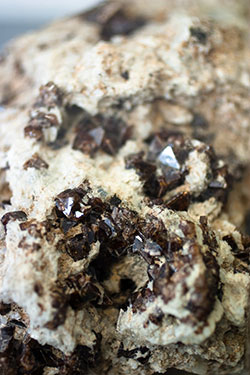Assessing Zircon’s Safety for Nuclear Waste Storage
 Zircon – A Potential Host for Storage of Radioactive Waste?
Zircon – A Potential Host for Storage of Radioactive Waste?
Due to its perceived mechanical and chemical durability, the mineral zircon (zirconium silicate) has been suggested as a potential host mineral for the long-term, safe encapsulation of nuclear waste. This notion of durability has emerged from the discovery of preserved zircon grains with ages close to the age of the Earth itself.
Assessing Zircon Stability – A Multi-Disciplinary Approach
The common methods for assessing mineral stability is flawed, however, when dealing with minerals prone to radiation damage, as their structures may undergo a series of time dependent transformations that have major effects on mineral stability.
The University's School of Geographical and Earth Sciences (GES) has been leading studies on the role of radiation damage in mineral stability, with analytical support from the Geoanalytical Electron Microscopy and Spectroscopy centre (GEMS), in GES, and the Kelvin Nanocharacterisation Centre (KNC), in the School of Physics & Astronomy (P&A).
This research links to activity in thermochronology (i.e., study of the thermal evolution of a region of the Earth’s crust) in GES, measuring the accumulation of radiation damage in minerals to assess their detailed thermal histories. The powerful combination of these centres and associated expertise at Glasgow University is unique in the UK.
ISAAC’s imaging capability enables a detailed assessment of the behaviour of zircon in a variety of crustal environments, providing realistic analogues for comparing behaviour of radioactive elements encapsulated in minerals over exceptionally long time scales and for assessing their reaction history and stability.
This project demonstrates the thorough characterisation of mineral grains that is required to understand their long-term geochemical behaviour, whether assessing the role of radiation damage on element mobility, the detailed pathways of fluid migration through rocks, or the evolution of porosity and permeability in hydrocarbon reservoir sandstones.
Download the Assessing Zircon's Safety for Nuclear Waste Storage case study.

